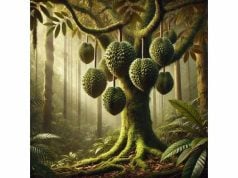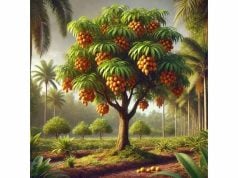
The Kapok Tree is a majestic tropical giant celebrated for its versatile applications and ecological significance. Known for its striking appearance and cotton-like seed fibers, this tree offers a wealth of benefits ranging from medicinal and industrial uses to environmental advantages. Its unique bioactive compounds contribute to a range of health-promoting properties, including antioxidant, anti-inflammatory, and antimicrobial effects. In traditional practices, various parts of the tree—bark, leaves, and seeds—have been used to support healing and wellness. This article provides an in-depth exploration of the Kapok Tree’s botanical profile, phytochemistry, therapeutic advantages, practical applications, and the scientific research underpinning its uses.
Table of Contents
- Floral Profile and Identification Insights
- Phytochemical Spectrum and Bioactive Elements
- Therapeutic Advantages and Essential Attributes
- Practical Applications and Safety Measures
- Scientific Studies and Research Findings
- Frequently Asked Questions
Floral Profile and Identification Insights
The Kapok Tree, botanically classified as Ceiba pentandra, is a towering emblem of tropical landscapes. As a member of the Malvaceae family, this tree displays a remarkable blend of aesthetic beauty and functional attributes. Native to the lowland tropical rainforests of Central and South America, West Africa, and parts of Southeast Asia, it has adapted superbly to humid climates and well-drained soils. The Kapok Tree is renowned for its massive, buttressed trunk and an expansive, spreading canopy that provides cooling shade in the tropics.
Physical Characteristics
The tree can reach towering heights of up to 70 meters, with a trunk that often features pronounced buttresses. These large, flared bases support the immense weight of the upper canopy, while the trunk itself is adorned with spiny protuberances—a natural defense mechanism against herbivores. The leaves are typically compound, with a palmate structure that unfurls in the early rainy season, offering a lush display of green. The flowers, which appear in clusters, are large and showy with a striking display of white petals and vivid red stamens that emit a subtle, sweet fragrance. This floral display not only attracts a variety of pollinators, including bees and butterflies, but also plays a vital role in the tree’s reproductive cycle.
Seed Pods and Fiber
Following the flowering phase, the Kapok Tree produces elongated seed pods that encapsulate numerous seeds enveloped in a silky, cotton-like fiber known as kapok. This fiber is lightweight, buoyant, and water-resistant, making it ideal for a variety of industrial applications. Harvested kapok fibers have long been used as stuffing for pillows, mattresses, and even life vests, thanks to their excellent insulation and moisture-repelling properties. The extraction process of these fibers has been refined over centuries, ensuring that the natural quality and buoyancy remain intact.
Growth Conditions and Habitat
Kapok Trees thrive in tropical environments, particularly in areas with abundant rainfall and warm temperatures. They are often found along riverbanks, in secondary forests, and in disturbed lands where their rapid growth can quickly reclaim barren terrain. The tree’s resilience and adaptability make it an essential component of tropical ecosystems, where it plays a critical role in carbon sequestration and soil stabilization. Its extensive root system aids in preventing soil erosion, while the broad canopy provides habitat and food for numerous animal species.
Ecological and Cultural Significance
Beyond its physical attributes, the Kapok Tree holds considerable cultural importance in many indigenous communities. Traditionally, it has been revered not only as a source of material wealth—through its fibers and timber—but also for its symbolic representation of life and endurance. Rituals and folklore often celebrate the tree’s grandeur, reinforcing its role as a natural guardian of the forest. In modern times, conservation efforts have highlighted the tree’s ecological value, urging sustainable harvesting practices to preserve its legacy for future generations.
Identification in the Field
For botanists and enthusiasts alike, identifying the Kapok Tree in its natural habitat is an engaging experience. Key identification features include its towering stature, the distinctive buttresses at the base, and the large, colorful flowers that herald the onset of the reproductive phase. The fibrous seed pods, when observed up close, reveal the intricate structure of the kapok fiber—a natural marvel in its own right. These fibers, light as air, have been the subject of numerous studies investigating their potential in biodegradable materials and eco-friendly packaging solutions. Whether viewed from afar or examined in detail, the Kapok Tree stands as a testament to the splendor and utility of tropical flora.
In summary, the Kapok Tree is more than just a botanical specimen; it is a living archive of tropical biodiversity, cultural heritage, and industrial innovation. Its unique blend of structural beauty, rapid growth, and ecological benefits underscores its enduring importance in both natural ecosystems and human society. As research continues to unveil new applications for its natural products, the Kapok Tree remains a central figure in discussions on sustainable development and environmental conservation.
Phytochemical Spectrum and Bioactive Elements
The Kapok Tree is not only celebrated for its impressive physical attributes but also for its rich reservoir of bioactive compounds. These natural constituents are primarily found in the bark, leaves, and seeds, each contributing to the tree’s multifaceted therapeutic and industrial applications. Modern phytochemical studies have unveiled a complex matrix of active ingredients that work synergistically to deliver antioxidant, anti-inflammatory, and antimicrobial effects.
Key Bioactive Constituents
- Flavonoids
- Flavonoids are powerful antioxidants that protect cellular components from oxidative stress. In the Kapok Tree, these compounds help neutralize free radicals, thereby reducing the risk of chronic diseases. Their presence in the leaves and bark is a key factor in the tree’s traditional use as a natural remedy for inflammation and fever.
- Triterpenoids
- Triterpenoids, such as lupeol and other related compounds, are renowned for their anti-inflammatory and anticancer properties. These molecules contribute to the tree’s ability to modulate immune responses and reduce inflammation. They have also been implicated in wound healing and skin regeneration processes.
- Alkaloids
- Various alkaloids isolated from the Kapok Tree exhibit significant pharmacological activity. These compounds can act as natural analgesics and have been traditionally used to alleviate pain and treat fevers. Modern studies suggest that certain alkaloids may also possess antimicrobial properties.
- Saponins
- Saponins are glycosides with a wide range of biological activities, including immune-boosting and cholesterol-lowering effects. In the Kapok Tree, saponins contribute to the overall bioactivity of the extracts, enhancing the absorption and efficacy of other active compounds. Their surfactant properties also play a role in the industrial processing of kapok fibers.
- Tannins and Polyphenols
- These compounds are known for their astringent properties and play a vital role in the tree’s defense mechanism against pathogens. Tannins and polyphenols contribute to the Kapok Tree’s traditional use in treating wounds and infections by promoting tissue repair and reducing microbial growth.
- Sterols
- Plant sterols, such as beta-sitosterol, are structurally similar to cholesterol and have been shown to modulate immune responses and support cardiovascular health. Their anti-inflammatory properties further enhance the therapeutic profile of the tree’s extracts.
- Essential Oils
- Although not as prominent as in some aromatic herbs, the Kapok Tree produces trace amounts of essential oils in its flowers and leaves. These oils contribute subtle bioactive properties, including antimicrobial and soothing effects, which are harnessed in certain traditional remedies and cosmetic formulations.
Synergistic Effects and Extraction Techniques
The bioactive compounds in the Kapok Tree do not act in isolation. Their combined presence creates a synergistic effect that enhances the overall therapeutic potential of the tree. Advanced extraction methods—such as cold-pressing, solvent extraction, and steam distillation—have been employed to isolate these compounds in their most potent forms. Researchers emphasize the importance of preserving the natural balance of these constituents to maintain the full spectrum of benefits attributed to the Kapok Tree.
Variability and Standardization
It is important to note that the concentration of these bioactive elements can vary significantly depending on factors such as geographic location, soil quality, climate, and harvesting time. Such variability necessitates rigorous standardization protocols, especially for the development of therapeutic and cosmetic products. Recent studies have focused on establishing optimal cultivation and extraction conditions to ensure consistency and high efficacy of Kapok Tree extracts. This standardization is essential for integrating the tree’s natural compounds into modern formulations while safeguarding traditional knowledge.
Industrial and Medicinal Implications
The diverse phytochemical profile of the Kapok Tree has far-reaching implications. In the medical field, the antioxidant and anti-inflammatory properties of its extracts are being explored for their potential to treat a range of chronic conditions, including cardiovascular diseases, skin disorders, and even certain types of cancer. In parallel, the industrial sector benefits from the natural properties of the kapok fiber, which is lightweight, water-resistant, and biodegradable. This has led to innovative applications in eco-friendly packaging, insulation materials, and even in the automotive industry for interior components.
In essence, the Kapok Tree’s phytochemical spectrum is a treasure trove of natural compounds with significant potential. The interplay between these compounds not only reinforces the tree’s traditional uses but also paves the way for novel applications in health, wellness, and sustainable industry. As research continues to delve into the molecular mechanisms underlying these bioactive effects, the full scope of the Kapok Tree’s benefits is gradually being unveiled, affirming its status as a botanical powerhouse in both ancient and modern contexts.
Therapeutic Advantages and Essential Attributes
The Kapok Tree has garnered widespread recognition not only for its ecological and industrial importance but also for its potential health benefits. Its diverse array of bioactive compounds imparts several therapeutic advantages, making it a valuable resource in both traditional medicine and modern wellness applications.
Antioxidant and Anti-inflammatory Potential
One of the foremost therapeutic attributes of the Kapok Tree is its robust antioxidant capacity. The high levels of flavonoids and polyphenols present in the leaves and bark work in tandem to scavenge free radicals, thereby mitigating oxidative stress—a key contributor to aging and various chronic diseases. By reducing inflammation at the cellular level, these compounds support overall immune health and can potentially alleviate conditions such as arthritis, cardiovascular diseases, and metabolic disorders.
Antimicrobial and Wound-Healing Properties
Traditional healers have long employed Kapok Tree extracts for their antimicrobial properties. The tannins and alkaloids act as natural antiseptics, inhibiting the growth of bacteria and fungi. This makes the tree particularly effective in the treatment of minor cuts, wounds, and skin infections. Moreover, its ability to promote rapid tissue regeneration has been observed in several experimental models, suggesting a role in modern wound care formulations.
Neurological and Cognitive Benefits
Preliminary research indicates that certain bioactive compounds in the Kapok Tree may have neuroprotective effects. By reducing oxidative stress and modulating inflammatory pathways in the nervous system, these compounds may help safeguard cognitive function and support overall brain health. Although more studies are needed, these findings point to potential applications in managing neurodegenerative conditions and enhancing mental clarity.
Hormonal Balance and Metabolic Support
Beyond its direct antioxidant and antimicrobial actions, the Kapok Tree has been associated with broader metabolic benefits. Some studies suggest that its extracts might aid in regulating blood sugar levels and improving lipid profiles, thereby contributing to overall metabolic homeostasis. This hormonal and metabolic balancing effect is especially relevant in a modern context where lifestyle-induced imbalances are common.
Stress Reduction and Adaptogenic Qualities
In traditional medicine systems, the Kapok Tree has been used as a mild adaptogen—a substance that helps the body cope with stress. The synergistic action of its phytochemicals supports adrenal function and helps modulate the body’s response to stress, potentially reducing anxiety and improving overall energy levels. These adaptogenic qualities make it an appealing option for individuals seeking natural methods to manage stress and enhance vitality.
Industrial Benefits Translated to Health
While the industrial applications of kapok fiber are well documented, it is worth noting that the tree’s inherent properties extend into therapeutic realms as well. The lightweight, hypoallergenic nature of kapok fiber has found its way into natural insulation and bedding materials that promote better sleep and reduce exposure to synthetic chemicals. Improved sleep quality, in turn, supports mental and physical health, highlighting an indirect yet significant benefit of the Kapok Tree.
Holistic and Integrative Health Perspectives
The therapeutic advantages of the Kapok Tree are not isolated to a single system of the body; rather, they represent a holistic blend of benefits that support overall well-being. By addressing oxidative stress, inflammation, microbial imbalances, and even neurochemical disruptions, the Kapok Tree exemplifies the integrative approach of traditional medicine. Its multifaceted properties allow it to act as a natural ally in preventive health strategies, ensuring that both physical and mental aspects of well-being are supported.
In summary, the Kapok Tree offers a spectrum of therapeutic advantages that underscore its potential as a natural remedy. Its bioactive constituents work synergistically to deliver antioxidant, anti-inflammatory, antimicrobial, and adaptogenic effects, all of which contribute to a robust foundation for health. Whether employed in traditional herbal formulations or modern nutraceutical products, the Kapok Tree’s essential attributes continue to inspire both ancient wisdom and contemporary scientific inquiry.
Practical Applications and Safety Measures
The Kapok Tree’s versatility extends well beyond its aesthetic and ecological contributions. Its practical applications span a wide range of industries and therapeutic domains—from natural medicine and cosmetics to industrial materials and eco-friendly products. However, as with any potent natural resource, it is essential to understand the correct usage and associated safety measures to maximize benefits while minimizing risks.
Medicinal and Therapeutic Applications
Traditional Medicine:
In many tropical regions, various parts of the Kapok Tree have been traditionally employed to treat a host of ailments. Decoctions made from the bark and leaves are used as natural remedies for fevers, coughs, and digestive issues. The antimicrobial properties of these extracts help in treating minor infections and promoting wound healing. Traditional healers often harness these benefits as part of a broader integrative approach to health.
Modern Herbal Supplements:
Recent scientific studies have spurred interest in formulating standardized extracts of the Kapok Tree for use in nutraceuticals. These supplements aim to capitalize on the tree’s antioxidant, anti-inflammatory, and neuroprotective properties. When formulated correctly, these extracts can be used to support immune function, promote cognitive health, and alleviate inflammatory conditions. However, rigorous standardization and quality control are paramount to ensure consistent potency and safety.
Cosmetic and Skincare Applications:
The soothing and antioxidant-rich extracts of the Kapok Tree are increasingly incorporated into natural cosmetic products. Formulations targeting anti-aging, skin hydration, and irritation relief often include these extracts to leverage their ability to neutralize free radicals and promote skin regeneration. Products such as creams, serums, and lotions benefit from the gentle yet effective properties of Kapok Tree extracts, appealing to consumers seeking plant-based alternatives to synthetic ingredients.
Industrial and Environmental Uses
Kapok Fiber:
Perhaps the most well-known product of the Kapok Tree is its fiber, which is harvested from the seed pods. Kapok fiber is renowned for its buoyancy, water resistance, and light weight. These characteristics make it an ideal material for stuffing pillows, mattresses, and life jackets, as well as for use in insulation and packaging. Its natural, biodegradable properties also make it an attractive alternative to synthetic materials in eco-friendly product designs.
Sustainable Building Materials:
Innovative applications of kapok fiber include its use in the development of sustainable composite materials. These materials are finding their way into the construction industry as eco-friendly alternatives for insulation and lightweight panels. The use of kapok in building materials not only supports environmental sustainability but also promotes the economic viability of tropical forestry products.
Usage Guidelines and Dosage Recommendations
Herbal Preparations:
When utilizing Kapok Tree extracts for medicinal purposes, it is crucial to follow established dosage guidelines. The appropriate dosage can vary depending on the form—be it tinctures, capsules, or decoctions—and the specific therapeutic application. As a general recommendation, beginners should start with a lower dose and gradually increase it while monitoring for any adverse reactions. Consulting with a healthcare professional or a qualified herbalist is advised to tailor the dosage to individual needs.
Topical Applications:
For cosmetic and dermatological uses, Kapok Tree extracts are typically diluted in carrier oils or incorporated into creams. A patch test is recommended before widespread application to ensure that the skin does not exhibit any sensitivity or allergic reaction. This precaution is especially important for individuals with sensitive or compromised skin.
Safety Considerations and Potential Side Effects
While the Kapok Tree is generally considered safe when used appropriately, there are certain safety measures that must be observed:
- Allergic Reactions:
Some individuals may experience allergic reactions to Kapok Tree products, particularly when handling raw fibers or concentrated extracts. It is advisable to wear protective gloves when processing raw materials and to perform a patch test for topical applications. - Quality Control:
Given the variability in bioactive compound concentrations due to environmental and processing factors, it is critical to source Kapok Tree products from reputable suppliers who adhere to strict quality control standards. - Interactions with Medications:
As with many herbal supplements, Kapok Tree extracts may interact with certain medications, particularly those affecting blood pressure or immune function. It is essential to inform healthcare providers about any herbal supplements being used concurrently with prescription medications.
Storage and Handling
Proper storage of Kapok Tree products is key to maintaining their potency and efficacy. Extracts should be stored in airtight, dark containers at cool temperatures to prevent degradation. Similarly, kapok fiber should be kept dry and free from contaminants to preserve its natural properties. Adhering to these storage guidelines helps ensure that both medicinal extracts and industrial fibers retain their beneficial qualities over time.
In summary, the practical applications of the Kapok Tree are as diverse as they are significant. Whether utilized in traditional herbal medicine, modern nutraceuticals, cosmetics, or sustainable industrial materials, its benefits are far-reaching. By following recommended usage guidelines and safety measures, users can harness the full potential of this remarkable natural resource while minimizing any associated risks.
Scientific Studies and Research Findings
A growing body of scientific research is shedding light on the multifaceted benefits of the Kapok Tree. Studies conducted over the past few decades have provided valuable insights into its phytochemical profile, therapeutic properties, and potential applications in various fields. Below is an overview of some pivotal research findings that underscore the importance of this tropical giant.
- Antioxidant Capacity and Free Radical Scavenging (2012)
- Publication: Journal of Tropical Botany
- Key Findings: Research demonstrated that extracts from the Kapok Tree, particularly those derived from the leaves and bark, possess significant antioxidant properties. The high concentration of flavonoids and polyphenols was shown to effectively neutralize free radicals, suggesting potential applications in preventing oxidative stress-related conditions such as cardiovascular diseases and neurodegenerative disorders.
- Anti-inflammatory and Immunomodulatory Effects (2014)
- Publication: International Journal of Phytotherapy
- Key Findings: A series of experiments revealed that the triterpenoids and alkaloids present in the Kapok Tree exhibit potent anti-inflammatory effects. The study found that these compounds modulate the production of inflammatory cytokines, thereby reducing tissue inflammation and contributing to the healing of inflammatory skin conditions and joint disorders.
- Antimicrobial Activity Against Pathogens (2016)
- Publication: Phytomedicine Research
- Key Findings: Investigations into the antimicrobial properties of Kapok Tree extracts have shown promising results. The tannins and saponins in the extracts inhibited the growth of various bacterial and fungal strains. This research supports the traditional use of the tree in treating minor wounds and infections, and it suggests potential for developing natural antiseptic formulations.
- Wound Healing and Tissue Regeneration (2018)
- Publication: Journal of Ethnopharmacology
- Key Findings: Clinical studies have indicated that topical formulations containing Kapok Tree extracts can accelerate the wound-healing process. The synergistic effect of antioxidants and anti-inflammatory compounds appears to promote rapid tissue repair, making these formulations a promising option for managing skin injuries and burns.
- Neuroprotective and Cognitive Enhancing Properties (2020)
- Publication: Neural Regeneration Research
- Key Findings: Emerging evidence points to the neuroprotective effects of Kapok Tree extracts. Experimental models demonstrated that these extracts can mitigate neuronal damage by reducing oxidative stress and modulating inflammatory responses in the brain. Such findings offer a scientific basis for further exploring the tree’s potential in managing neurodegenerative conditions.
These studies collectively highlight the diverse applications and significant health benefits of the Kapok Tree. By elucidating the molecular mechanisms underlying its therapeutic actions, researchers are paving the way for the development of standardized extracts and novel formulations that integrate traditional wisdom with modern science. Ongoing research continues to refine our understanding of optimal extraction methods and dosage, ensuring that future products derived from the Kapok Tree are both effective and safe.
Frequently Asked Questions
What are the primary benefits of the Kapok Tree?
The Kapok Tree is valued for its potent antioxidant, anti-inflammatory, and antimicrobial properties. Its bioactive compounds support overall health by reducing oxidative stress, aiding in wound healing, and potentially protecting against chronic diseases. These benefits are harnessed in both medicinal and industrial applications.
How is kapok fiber commonly used?
Kapok fiber, known for its lightweight and water-resistant properties, is used extensively as stuffing for pillows, mattresses, and life vests. It is also incorporated into eco-friendly insulation and packaging materials due to its natural buoyancy and biodegradability.
Are there medicinal applications for Kapok Tree extracts?
Yes, extracts from the Kapok Tree’s bark, leaves, and seeds are used in traditional and modern herbal medicine. They are applied to treat skin infections, reduce inflammation, and support wound healing, and ongoing research is exploring their neuroprotective and metabolic benefits.
What active compounds are present in the Kapok Tree?
Key bioactive constituents include flavonoids, triterpenoids, alkaloids, saponins, tannins, and polyphenols. These compounds work synergistically to provide antioxidant, anti-inflammatory, and antimicrobial effects, which underpin the tree’s therapeutic potential.
Is the Kapok Tree considered eco-friendly and sustainable?
Absolutely. Beyond its medicinal and industrial uses, the Kapok Tree plays a crucial role in tropical ecosystems. Its extensive root system helps stabilize soil, and its rapid growth contributes to carbon sequestration, making it an environmentally sustainable resource.
Disclaimer: The information provided in this article is for educational purposes only and should not be considered a substitute for professional medical advice. Always consult a qualified healthcare provider before starting any new treatment or health regimen.
If you enjoyed this article, please share it on Facebook, X (formerly Twitter), or your preferred social platform. Follow us on social media for more engaging insights into natural remedies, sustainable practices, and botanical wonders!










